I am finishing the writing of this log in Manchester in the UK under heavy grey skies and intermittent pouring rain: I started it whilst we were in the Bay area of San Francisco when Sterling was attending a Glass Developer conference at the end of October.
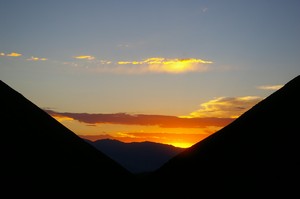
We decide to stay in Death Valley for a few more days after Vinny and Aileen leave and head up to the mountains to WildRose campground. It’s a different world up here. Its cooler: about 20 degrees or so. It’s hilly, with juniper and pinyon pines scattered across the slopes. We’re trying to get back to a life pattern less dominated by work, so while we’ve got lots to catch up with in the aftermath of our break, we’re also determined to make time to enjoy where we are.
This is the less well known side of Death Valley: tight interlocking valleys, mountains and wide bowls of sparse vegetation. To get to the WildRose trail head, we drive the six miles, much on a delightful unpaved road with some of the most amazing corrugations we’ve ever experienced. The trail starts from the site of the ten beehive charcoal kilns built in the later part of the eighteen hundreds by Chinese labourers, to supply the smelter at a gold mine thirty miles away.
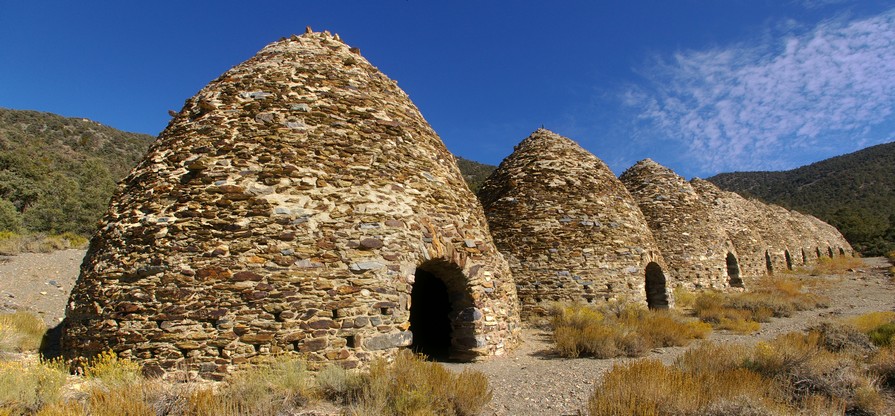 It is such a remote place that it’s difficult to understand the motivation in building them but of course in an area with such little vegetation, even the relatively sparse pinyons were extremely valuable. The were cut, the kilns packed, the firing process taking up to eight days, the cooling another five, before the charcoal was loaded in carts and taken to the mine. They have a beautiful symmetry, lined up in a straight line, their convex curves mirroring each other, their pointy tops the perfect finish.
It is such a remote place that it’s difficult to understand the motivation in building them but of course in an area with such little vegetation, even the relatively sparse pinyons were extremely valuable. The were cut, the kilns packed, the firing process taking up to eight days, the cooling another five, before the charcoal was loaded in carts and taken to the mine. They have a beautiful symmetry, lined up in a straight line, their convex curves mirroring each other, their pointy tops the perfect finish.
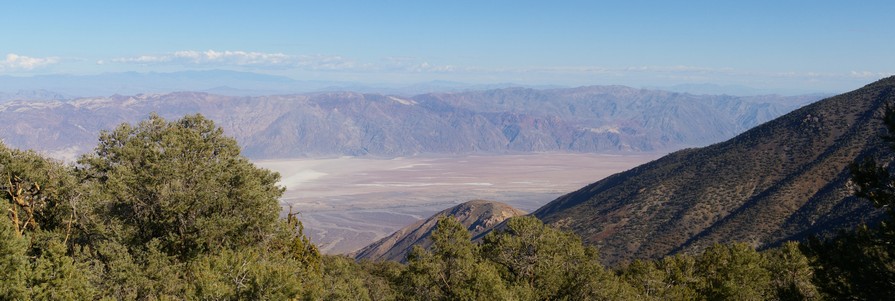
It’s lovely to be out on the trail. It’s very unlike the more familiar part of the park until we get to the ridge and there far below us are the washed out familiar colours of the valley itself, its flat expanse looking so much smaller at this distance. Having set out late-ish, we don’t have time to go all the way to the peak but it’s still worth the hike we do to see the views.
 We’re planning one more night back on the valley floor before we leave so that we can do the circular hike up Golden Canyon, across the badlands and back out to the edge of the valley of death. It’s a great walk: the colours, textures and shapes of the surrounding rocks along with glimpses out to the valley and mountains beyond make it fascinating. Well worth the extra day.
We’re planning one more night back on the valley floor before we leave so that we can do the circular hike up Golden Canyon, across the badlands and back out to the edge of the valley of death. It’s a great walk: the colours, textures and shapes of the surrounding rocks along with glimpses out to the valley and mountains beyond make it fascinating. Well worth the extra day.
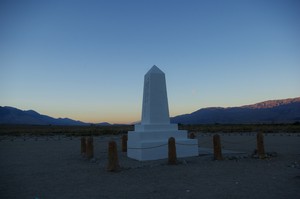 Just for a change, time is on our tail. We’re due in the Bay area before the end of the month and want to meander up the Owens Valley to the east of the Sierra Nevada before crossing over via Yosemite.
Just for a change, time is on our tail. We’re due in the Bay area before the end of the month and want to meander up the Owens Valley to the east of the Sierra Nevada before crossing over via Yosemite.
Our first stop in Owens Valley is at the Manzanar National Historic Site: the location of one of the detention camps where people of Japanese descent were held during the second world war. It’s a deeply moving experience, the words of the detainees speaking for themselves of the horror of being wrenched from their homes, businesses, work and lives, of losing everything they possessed and being herded into barracks with no privacy, toilets with no cubicles and armed guard towers around the periphery. For all this, the government of the day maintained an insistence that this was not incarceration.
 Owens Valley is home to a string of small towns and we stop in a county park in Independence for a couple of nights while we catch up with some work. The Sierra Nevada rises steeply from the valley floor, its sharp outlines and cutting edges a testament to its youth. The appearance of the many faceted slopes of the range change in the varying tones of light throughout the day: orange in the glowing light of dawn, a brief burst of red before the first direct rays hit, illuminating with startling clarity, a gradual haziness creeping in with the afternoon sun ahead of the sharpening silhouette against the robin’s egg blue of the western evening sky. They are spectacular mountains.
Owens Valley is home to a string of small towns and we stop in a county park in Independence for a couple of nights while we catch up with some work. The Sierra Nevada rises steeply from the valley floor, its sharp outlines and cutting edges a testament to its youth. The appearance of the many faceted slopes of the range change in the varying tones of light throughout the day: orange in the glowing light of dawn, a brief burst of red before the first direct rays hit, illuminating with startling clarity, a gradual haziness creeping in with the afternoon sun ahead of the sharpening silhouette against the robin’s egg blue of the western evening sky. They are spectacular mountains.
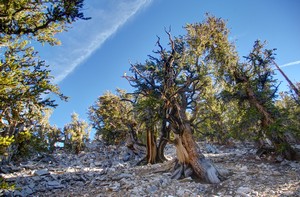 On the eastern side of the valley, The White Mountains are older, rounder and less dramatic. They have their own attractions: up in the mountains, fifteen miles from the valley floor is the Ancient Bristlecone Pine Forest. These gnarled and twisted trees are thought to be the earth’s oldest living non-clonal organism: the most mature tree currently dated to over five thousand years. Their height and girth belie their age but their contortions produce individuals of amazing shapes: their incredibly slow growing rate a result of harsh climatic conditions exacerbated by high altitudes and poor soils produced by the Dolomite bedrock. Their durability is, at least in part, due to the extreme density of the wood and its high resin content.
On the eastern side of the valley, The White Mountains are older, rounder and less dramatic. They have their own attractions: up in the mountains, fifteen miles from the valley floor is the Ancient Bristlecone Pine Forest. These gnarled and twisted trees are thought to be the earth’s oldest living non-clonal organism: the most mature tree currently dated to over five thousand years. Their height and girth belie their age but their contortions produce individuals of amazing shapes: their incredibly slow growing rate a result of harsh climatic conditions exacerbated by high altitudes and poor soils produced by the Dolomite bedrock. Their durability is, at least in part, due to the extreme density of the wood and its high resin content.
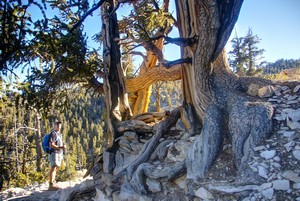 Sterling remembers learning about these trees as a child and being singularly unimpressed by their dwarfed stature. Wandering along the path through the Methuselah Grove he concedes that they’re much more impressive in reality than they appeared on the printed page all those years ago. We have arrived late in the afternoon and by the time we’re completing the four and a half mile trail, the light is fading, making photography difficult, but bringing a crisp coolness to the air and a sense of the approaching autumn.
Sterling remembers learning about these trees as a child and being singularly unimpressed by their dwarfed stature. Wandering along the path through the Methuselah Grove he concedes that they’re much more impressive in reality than they appeared on the printed page all those years ago. We have arrived late in the afternoon and by the time we’re completing the four and a half mile trail, the light is fading, making photography difficult, but bringing a crisp coolness to the air and a sense of the approaching autumn.
Coming down from the White Mountains, we stop in Bishop where I have what is probably my all time worst haircut. I’ve returned to very short hair since coming back into the camper but am beginning to think this is a serious mistake. For some reason, which I fail to understand, American hairdressers seem incapable of cutting womens hair in a short sharp style. Instead they hack away at it, this time chopping half my fringe (bangs) far too short, butchering the rest in a generally uneven mess and for good measure leaving some strands untouched requiring Sterling to take the scissors to it afterwards. Atrocious haircuts seem part of life on the road and I have yet to find a solution. I went through a period of taking photographs of the style I wanted but this proved an utter failure and Sterling did point out that some cutting skill was needed to translate picture into reality. I’m really not sure what I’m going to try next but in the meanwhile I’ll just have to rely on the brown paper bag trick.
On a brighter note, there’s a developed open air hot springs a few miles out of town and we head there so that I can chill! The structure dates back to the late nineteen twenties and in fairness is probably going to need some serious work if it’s going to survive. In spite of the fact that its worn round the edges, the large swimming pool is a delight and the hot pool, while shallow has the desired effect and I emerge relaxed, laid back and oblivious to the hack job on my head.
 Towards the northern end of Owen Valley lies the stunning Mono Lake. It sits in part of the Mono Basin, an active geological area, has no outlet and consequently has a high salt concentration. It’s an oasis in the high desert attracting millions of migrating birds each year. To the west of the basin rise the thirteen thousand foot peaks of the Sierra Nevada while to the south lie the cinder cones of the Mono Crater volcanos. The colours of the land are muted, the water startlingly blue in comparison.
Towards the northern end of Owen Valley lies the stunning Mono Lake. It sits in part of the Mono Basin, an active geological area, has no outlet and consequently has a high salt concentration. It’s an oasis in the high desert attracting millions of migrating birds each year. To the west of the basin rise the thirteen thousand foot peaks of the Sierra Nevada while to the south lie the cinder cones of the Mono Crater volcanos. The colours of the land are muted, the water startlingly blue in comparison.
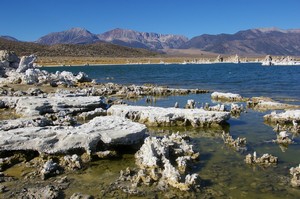 In the early nineteen forties, the city of Los Angeles spread it’s water grabbing fingers this far north and diverted a significant amount of water from the streams feeding the lake. The equilibrium of the system was broken, the volume almost halved, the salinity dramatically increased. The diversion was curtailed through legislation in 1994 and since then the level of the lake has gradually been increasing, although the drought of recent years has hindered anticipated progress.
In the early nineteen forties, the city of Los Angeles spread it’s water grabbing fingers this far north and diverted a significant amount of water from the streams feeding the lake. The equilibrium of the system was broken, the volume almost halved, the salinity dramatically increased. The diversion was curtailed through legislation in 1994 and since then the level of the lake has gradually been increasing, although the drought of recent years has hindered anticipated progress.
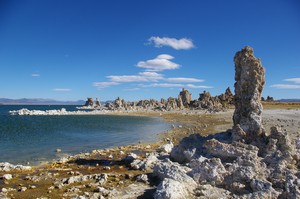
Around the edge of the lake and standing proud above the water surface are the limestone tufa towers that bring an additional fascination to this landscape. The towers develop underwater at points where calcium rich springs enter the water which is loaded with carbonates. The two combine and deposit calcium carbonate, or limestone around the spring, building up over time to produce the columns: they stand revealed today as a result of the drop in water level. There is an otherworldliness here, a stark landscape of incredible and unusual beauty rendered with startling clarity in the thin clear air.
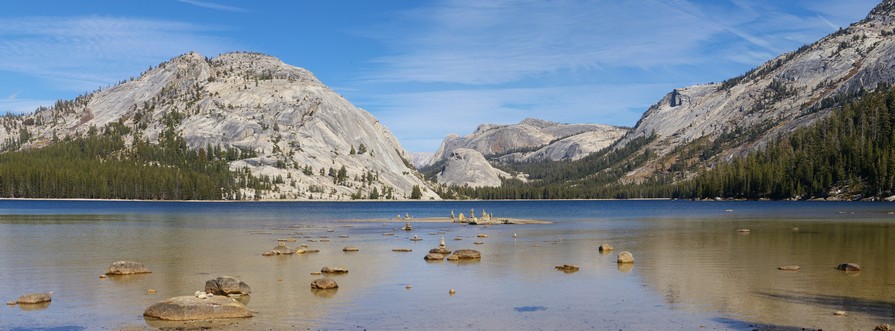 A few days later we cross the Sierra Nevada through Yosemite National Park heading for a stop at an Escapees park where we can detach, get some corporate work done as well as give Sterling time to install our new inverter that has been sitting in its box for some weeks. Having detached upon arrival we are told the next morning that California law will not allow us to remain detached if we are in the camper. We decide to have a day out before we reattach and head back into Yosemite to walk amongst the big trees.
A few days later we cross the Sierra Nevada through Yosemite National Park heading for a stop at an Escapees park where we can detach, get some corporate work done as well as give Sterling time to install our new inverter that has been sitting in its box for some weeks. Having detached upon arrival we are told the next morning that California law will not allow us to remain detached if we are in the camper. We decide to have a day out before we reattach and head back into Yosemite to walk amongst the big trees.
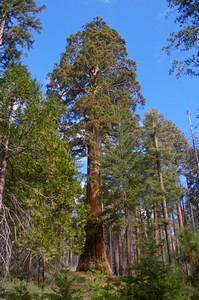 It’s many years since we’ve seen Sequoias and as we drive into the Mariposa Grove trailhead carpark we are jolted by the enormity of the trees standing disproportionately tall next to their normal sized neighbours. The Bristlecones are still sharp in our memories but however amazing their age, the visual impact of the Sequoias is more immediately impressive. We have to tip our heads right back to see the tops of these giants, their girths so wide that in the past they have had tunnels cut through them, wide enough for cars. Such circus tricks are a thing of the past, but the remnant of one such tree lies on it’s side, fallen young because of its weakened state.
It’s many years since we’ve seen Sequoias and as we drive into the Mariposa Grove trailhead carpark we are jolted by the enormity of the trees standing disproportionately tall next to their normal sized neighbours. The Bristlecones are still sharp in our memories but however amazing their age, the visual impact of the Sequoias is more immediately impressive. We have to tip our heads right back to see the tops of these giants, their girths so wide that in the past they have had tunnels cut through them, wide enough for cars. Such circus tricks are a thing of the past, but the remnant of one such tree lies on it’s side, fallen young because of its weakened state.
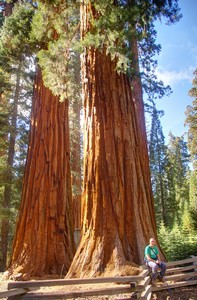 Even in repose, these trunks are impressive, full sized people rendered miniature in comparison. The trail takes us six miles up to the ridge and back around, a delight at every bend, the giants making this another world, a Tolkienesque experience.
Even in repose, these trunks are impressive, full sized people rendered miniature in comparison. The trail takes us six miles up to the ridge and back around, a delight at every bend, the giants making this another world, a Tolkienesque experience.
Back in the real world and ahead of flying out to the UK, Sterling has two days at the conference while I do the trip preparation and visit the dentist with a cracked tooth. It needs crowning and I have an appointment for the day after our return. Not exactly the home-going of choice.